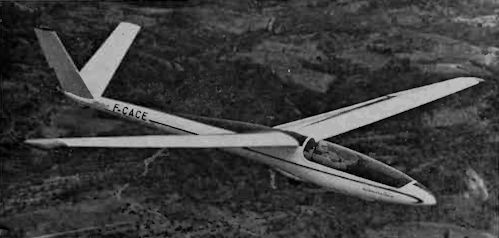
M.Hardy. Gliders & Sailplanes of the world
Siren C 30S Edelweiss
This very elegant high performance Standard Class single-seater was designed by Dr J. Cayla, who had created the Breguet 901 and 905 Fauvette, and like the latter it features a V-tail and makes use of moulded plywood/Klegecel sandwich in its structure. The first of two Edelweiss prototypes made its maiden flight on 25 September 1962, and both prototypes took part in the 1963 World Championships at Junin in Argentina, finishing 2nd, flown by Jacki Lacheny of France, and 17th in the Standard Class contest. The prototype differed from production aircraft in having a slight forward wing sweep, longer span ailerons and air brakes and a longer fuselage nose. The first of an initial production batch of 15 was completed in January 1965, and one of these, piloted by Francois Henry, won the Standard Class section of the 1965 World Championships held at South Cerney, while another Edelweiss was placed 7th; two others of the type also finished 8th and 10th in the Open Class. The Edelweiss is no longer in production, but 50 had been delivered by 1 March 1968. The cantilever single-spar shoulder wings are foam-filled all-wood structures with only eight ribs, of sandwich construction, and are covered by a plywood/Klegecel sandwich skin 8mm thick; the down-turned wing tips are of reinforced plastics and the unslotted ailerons are all-metal. The air brakes in the upper and lower wing surfaces are interconnected with the hydraulic monowheel brake, and up to 110lb of ballast in the form of eight lead bars can be mounted in the wing roots so that the wing-loading can be varied; unlike the more conventional water ballast, this kind cannot be jettisoned. The fuselage is a moulded plywood/Klegecel sandwich structure made in two portions, with integral longerons and nose and tail cones made of laminated plastics. The V-tail consists of two identical all-moving surfaces, with an included angle of 90°, each with a trim tab; the leading edges are of wooden sandwich construction and the remainder is fabric-covered. There is a non-retractable monowheel with a hydraulic brake, and a castoring leaf-spring tailskid. The pilot sits in a semi-reclining seat under a long flush-fitting canopy hinged to starboard, and optional 'extras' that may be installed include a barograph, VHP radio, an oxygen system, artifical horizon, a Jaeger altimeter and a flight calculator.
The Edelweiss IV was an Open Class version with a wing span increased to 17.5m (57ft 4 3/4 in) and the length increased to 25ft 7in. The first of two prototypes of the Mk IV flew on 9 May 1968 but it did not go into production, and differed in some respects in structure from the earlier Edelweiss. The wings were built in two panels, with sandwich skins and pinch-webbed spars with spruce booms, and the fuselage was of completely moulded sandwich construction with built-in spruce longerons, and laminated plastic nose and tail cones. The monowheel was now retractable, and the wheel brake was also connected to operate with the air brakes.
Data: C30S Edelweiss
Span: 49 ft 2 1/2 in
Length: 24 ft 7 1/4 in
Wing area: 133.9 sqft
Aspect ratio: 18.0
Empty weight: 518 lb
Max weight: 838 lb
Max speed: 140 mph (in smooth air)
Max aero-tow speed: 112 mph
Min sinking speed: 2.1 ft/sec at 50 mph
Best glide ratio: 36:1 at 59 mph
- M.Hardy. Gliders & Sailplanes of the world
Фотографии
-
Jane's All the World Aircraft 1964 / 03 - Sailplanes
Регистрационный номер: F-CACE [2] Siren C.30 Edelweiss single-seat Standard Class sailplane
-
Jane's All the World Aircraft 1966 / 05 - Sailplanes
Регистрационный номер: F-CACE [2] Siren C.30 Edelweiss single-seat Standard Class sailplane
-
GL 1982- / M.Hardy - Gliders and Sailplanes /Gliders & Sailplanes of the world/ (1)
Регистрационный номер: F-CCCZ Siren C.30S Edelweiss.
-
Jane's All the World Aircraft 1972 / 03 - Sailplanes
Siren Edelweiss IV single-seat Open Class sailplane
- Фотографии



